Whether you’re a beginner at kayaking or an expert, kayaking in the ocean can be a little intimidating at first.
It’s also an extremely exhilarating experience that is worth an attempt, as long as you remain aware and follow all the necessary safety protocols.
However, ocean kayaking is generally not recommended for total kayaking beginners.
If you are completely new to the world of kayaking, start off in more protected areas, that are less exposed to strong currents, wind and choppy waves.
A small bay which has calmer waters would be a nice and peaceful place to start your foray into sea kayaking.
If you’re a little nervous and want to learn more about how to kayak in the ocean (and especially how to kayak in rough water), you’re in the right place.
Here’s our guide of important things to keep in mind, and potential dangers to be aware of, before kicking off your sea kayaking adventures.
Ocean kayaking basics
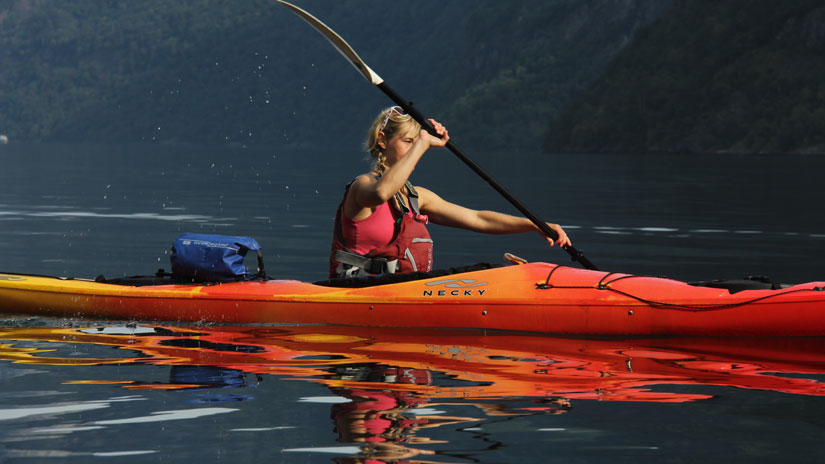
- First things first, you need to learn (and master) your basic kayaking strokes in calmer waters, before you attempt to face the ocean. Learn how to use your body to skillfully move your kayak in every direction. Only once you are comfortable with your command of the kayak should you attempt to take it out to sea.
- It isn’t just paddling techniques that you need to learn before you set off. Learn the basic rules of water safety, as well as how to perform essential first aid techniques. Knowing how to rescue yourself in calm and shallow waters is also a good idea before you face the more extreme conditions of the sea.
- Make sure you have the right equipment and gear for kayaking in the ocean. You’ll need all the essentials such as a sturdy personal flotation device, a durable waterproof bag to store your belongings, a radio, food and water, and a good paddle (with a spare).
Other things which we recommend taking along for an ocean kayaking trip include a backrest, first aid kit, safety whistle, and any navigation materials for longer trips such as a map and compass. Oh, and sunscreen and a hat if you’re blessed with sunny weather on the day of your trip!

- Clothing-wise, your outfit won’t differ much compared to what you would wear while kayaking on rivers and lakes. Make sure you wear a base layer top in case your outer layers get wet and bring a spare set of clothes in case of capsizing.
- As mentioned earlier, a personal flotation device (PFD) is a must as head out into the ocean. Invest in a PFD that fits well and make sure you wear it. Not only is this important for your own personal safety, but it is also required by Coast Guard regulations that you have a life jacket on board when you go kayaking in the sea.
Bonus: your life jacket will also keep you nicely warm and insulated during chilly weather.
Ocean kayaking tips
- As with all water activities, following safety procedures is key. This is especially crucial in the ocean, where conditions can often be unpredictable.
- It goes without saying that you should check the weather conditions before your trip. This will help you be well prepared, and you can plan your outfit accordingly. Keep in mind though, that there could be sudden changes in the weather and some conditions are unsuitable for ocean kayaking. There also may be offshore winds that could make it more difficult for you to return to shore. A quick bit of online research on the area could be hugely helpful.
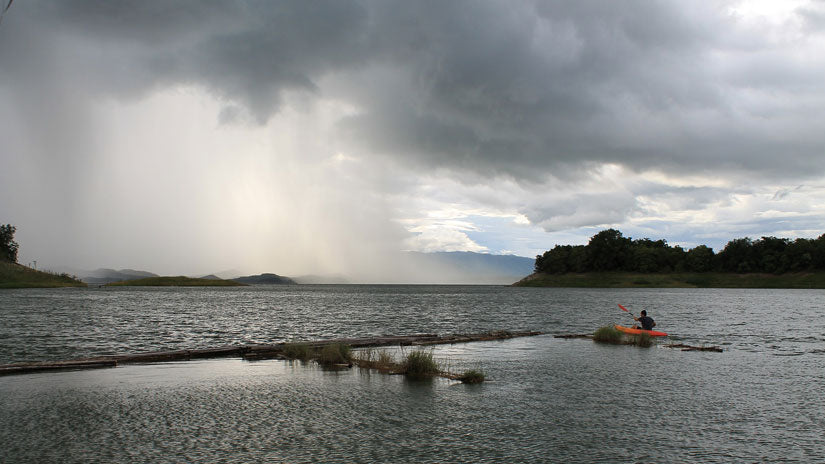
If the area you will be kayaking in will be completely new to you, check with the locals about current and shoreline conditions, as well as any weather patterns that you should be aware of. They may also be able to recommend the best time of the day to head out, and best launch spots to start from.
- New to ocean kayaking? Plan your first trip close to the shoreline. In the event that you capsize, it’ll be easier to swim back to the shore if you find yourself unable to get back into your boat. Learning how to kayak in rougher waters takes time and practice.
- Always be aware of the water temperature before you set off on a sea kayaking trip. If it looks to be quite cold, it’s recommended that you wear a wetsuit in case of a boat capsize.
- If you’re wondering what type of kayak is more suited for sea kayaking, a sit-in kayak can help keep you a little more protected from the elements. A sit-on-top kayak can also offer a great experience, but it does mean that you’re more exposed while out at sea.
- Whichever boat you decide to opt for, check the weight capacity before you load yourself and your things into it.
- Inspect all the equipment that you’ll take with you on your trip. It is worth checking for any wear and tear before you embark on your journey. For instance, make sure your dry bag is damage free so your belongings within are kept nice and dry.
- There may be specific rules for kayaking at the beach and area you plan your trip in. Make sure you check these out before you go, or ask someone if you’re unsure.
- You need all your senses to be fully alert when you go ocean kayaking. Drinking alcohol is not recommended before or during your trip.
- Drinking water, however, is key. Ocean kayaking can consume a lot more of your energy than you think, so remaining hydrated is of the utmost importance. You can invest in a hydration pack which is designed to quench your thirst without hindering your movements.
- Food-wise, nutrition bars would take up the least amount of space and keep your energy levels up as you navigate the water. Make sure you take plenty along for everyone on board.
- Once you’ve planned out your ocean kayaking trip, inform someone (who’ll be remaining on land!) of the route you will be taking, how many people are going with you, and how long you plan to be gone for. Once you’ve informed someone of your plan, stick with it. They’ll be able to find you more quickly in case of any emergencies.
How to kayak with waves
Experiencing waves is inevitable while kayaking in the sea. Therefore, there are specific boats designed especially for ocean kayaking. Most waves are under 3 feet and easy to navigate, but it can be extremely difficult to handle larger breaking waves. Take a helmet along with you and be prepared for the fact that paddling around in big waves could lead to your boat capsizing.
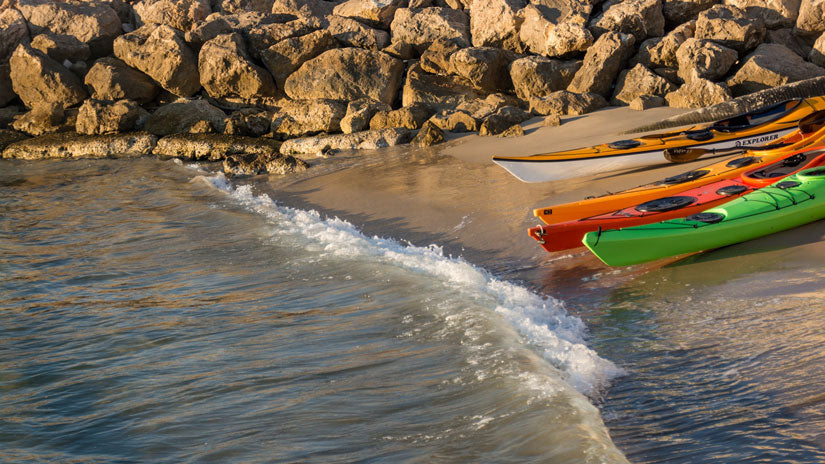
Again, it isn’t a good idea for beginner kayakers to head to an area with high waves. Start off by sticking to those areas that have a more gradual shoreline, and where the waves are lower. That’s where you should first launch from, starting off in waters that are knee deep.
Once you get into the kayak (quickly) set off with a strong and swift forward stroke to deal with any incoming breakers.
When first starting out, plan your trip to be a swimmable distance of the shoreline until you’ve learned the necessary paddling skills needed to handle rougher waters and choppier waves.
If you are heading out into an area where the waves look to be strong, capsizing could potentially occur. This is one of the main fears that many kayakers have about paddling in the ocean.
To overcome this fear, get comfortable with capsizing! As strange as that may sound if you learn and practice how to re-enter your kayak with ease even while out in deeper waters, you will be more self-assured and able to do so in case it happens during your trip.
Kayaking in the ocean dangers
Although kayaking is known to be one of the safest activities, especially if you follow general good practice tips for safety, there is always a risk involved with water sports. When it comes to ocean kayaking, it’s important to be aware and fully prepared to deal with the ever-changing and dynamic conditions of the sea waters.
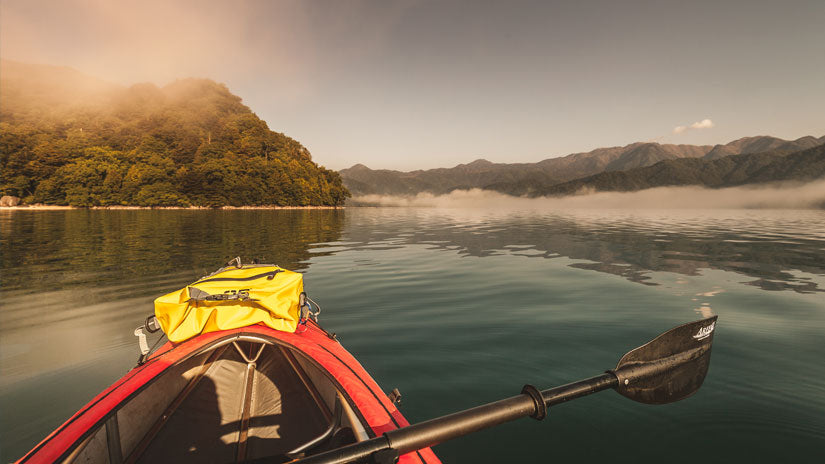
Here are some of the potential kayaking in the ocean dangers to keep in mind before you set off on your adventure:
Strong current conditions:
Be aware of current conditions in the area that you plan your trip in. Although you may have previously faced strong currents when kayaking in rivers, tidal areas in the ocean can also have particularly intense ones. They can take you much further than you started, without you even realising it.
Whether the currents are ripping or tidal, both can prove a challenge for kayakers. Try not to panic and put your kayaking skills to use to get back to shore!
Hypothermia:
Planning to go ocean kayaking when it’s colder out?
It is possible to get hypothermia if your boat capsizes and you’re submerged in icy water. Although this isn’t something that many think of when planning their trip, this is much more likely to happen than encountering sharks, for instance!
Wearing a wet (or dry) suit is a good idea once you’ve checked the weather forecast for your trip.
Also, if you have enough flotation equipment in your kayak and the means to send out a distress signal, you’re more prepared for any potential rescue operations that may be required in case of a boat capsize.
Hypothermia can also occur if the temperature drops suddenly, or if you get lost out at sea during chillier weather.
Travelling too far from the shoreline in bad weather conditions:
The unpredictable nature of the ocean does mean that kayaking too far from land comes with quite a few risks. If the weather or water conditions change suddenly, it is advisable to be closer to shore.
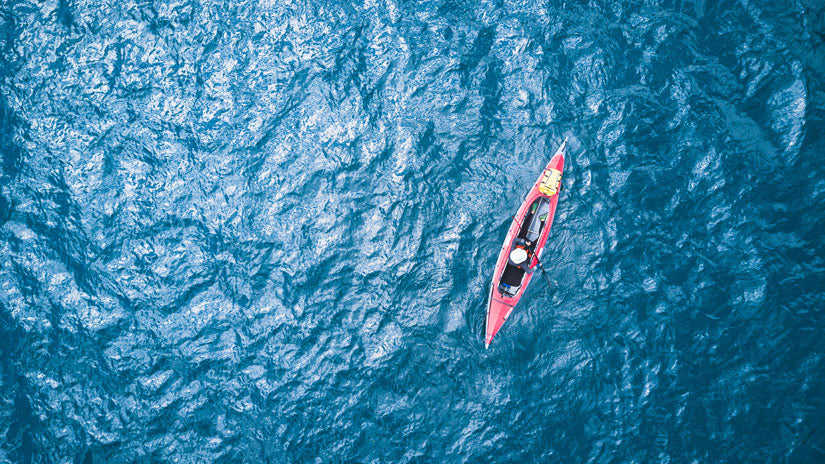
In case of a boat capsize where you’re unable to reenter, you can get extremely tired swimming back to shore (unless you’re an experienced long-distance swimmer accustomed to navigating big waves, of course!)
Thunderstorms:
It’s a scary sight (and sound) to experience a thunderstorm while out at sea. If you hear even a hint of thunder while kayaking in the ocean, head to the shore immediately. Lightning is more likely to hit any high objects, so keep your paddles at a low angled stroke and keep your head down. Anything metal should be removed out of sight where possible.
Passing ships:
Watch out for any bigger boats in the area. They can move quicker than you might think, and they might not be able to spot your little kayak. Steer well clear of the path of any large boats or ships you spot.
To make it easier for other boats to spot you, stay close to your group and wear bright and easily visible clothing and life jackets.
Kayaking in the ocean with sharks:
One of the most common fears that ocean kayakers face is encountering sharks. And while it’s not a completely invalid concern, in most areas, it is highly unlikely.
Do a bit of research on the area you’re heading out into to check whether there have been any shark sightings at all.
There are many reasons why a kayak lover would want to head out into the ocean. Not only is it a fantastic workout, but it’s also a great adventure and an unforgettable experience.
Sure, there are some dangers and risks associated with it, but if you follow the guidance in this article and are informed about the area you’ll be heading out in, you should be completely fine.
Ready for your next kayaking adventure? Our full range of waterproof bags and dry bags offers you the perfect equipment for your trip.
Happy kayaking!
